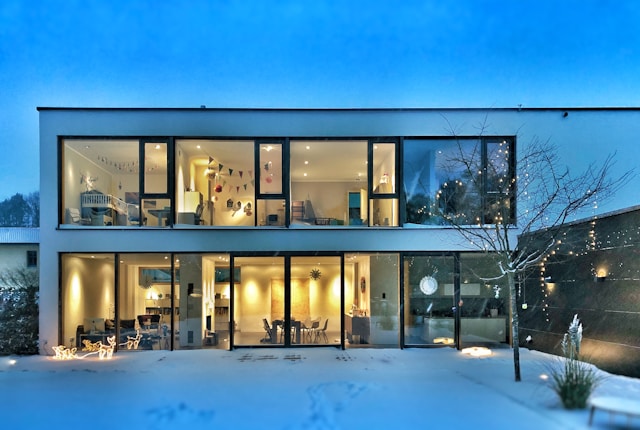Building a new home is the perfect opportunity to future-proof your space with smart technology. As homes become more intelligent, integrating automation, energy efficiency, and sustainable solutions during the construction phase ensures your property is not only modern today but prepared for tomorrow. Here’s a complete guide on how to build a house that’s ready for a smart future.
1. Design with Technology in Mind
Before you lay the foundation, work with your architect or builder to incorporate smart home planning into your blueprint. Pre-wiring for systems like internet, security cameras, smart lighting, and home automation can save you thousands in future retrofits.
Consider:
-
Ethernet wiring to key locations for faster, more reliable connections.
-
Wall outlets with USB ports.
-
Dedicated tech closets for routers and smart hubs.
-
Open wall conduits to allow easy cable upgrades later.
Tip: According to the Consumer Technology Association, 69% of U.S. households already own at least one smart device, and this number continues to rise.
2. Smart Thermostats for Comfort and Savings
A smart thermostat can reduce energy bills by up to 23%, based on data from ENERGY STAR. Devices like the Nest Learning Thermostat or Ecobee adapt to your routine, automatically adjusting the temperature based on occupancy or weather.
Smart thermostats can also:
-
Be controlled remotely from your phone.
-
Integrate with voice assistants like Alexa or Google Home.
-
Send alerts when your system needs maintenance.
3. Set Up a High-Tech Home Office
With more people working remotely, a smart home office is a must-have. Design this space for maximum productivity and connectivity.
Suggestions:
-
Install soundproofing for video call clarity.
-
Integrate motorized blinds and smart lighting to reduce screen glare.
-
Use a dedicated Wi-Fi mesh system to ensure a strong connection.
Fun Fact: The number of remote workers in the U.S. tripled between 2019 and 2021—designing with this shift in mind can add value and appeal to future buyers.
4. Power Up with Solar Panels
Solar energy is no longer just a green trend—it’s a smart investment. Installing solar panels during the building phase is more cost-effective and seamless than retrofitting them later.
Key benefits:
-
Reduce your electric bill by up to 70% annually.
-
Increase home resale value—studies show homes with solar sell for about 4.1% more on average.
-
Pair with a solar battery for energy storage and blackout protection.
For maximum efficiency, ensure your roof is angled and oriented correctly for optimal sun exposure.
5. Invest in Superior Insulation
Energy efficiency starts at the structural level. Investing in high-quality insulation can reduce energy usage by up to 30% and improve comfort year-round.
One smart solution is Slabmate insulation, a rigid insulation board placed beneath concrete slabs to reduce heat loss through the foundation. This not only improves thermal performance but also contributes to better soundproofing and indoor air quality.
Combine Slabmate with other materials like spray foam, blown-in cellulose, or fiberglass batts in walls and attics for a well-insulated smart home.
6. Smart Technology: What to Add Now
When building for the future, consider smart technology as a foundational element—not an afterthought. Popular smart home devices to integrate include:
-
Smart Lighting: Adjust brightness and color via apps or voice. Set schedules or automate with motion sensors.
-
Smart Security Systems: Cameras, video doorbells, and alarms that notify you in real time.
-
Voice Assistants: Centralize control of your home via Amazon Alexa, Google Assistant, or Apple HomeKit.
-
Smart Appliances: From ovens to washers, these devices can help you monitor energy usage and run more efficiently.
Planning wiring and placement for these systems during construction ensures seamless integration and less clutter.
7. Build with Sustainability in Mind
Sustainability goes hand in hand with smart home planning. Choose eco-friendly materials like reclaimed wood, bamboo flooring, and low-VOC paints. Install low-flow fixtures to reduce water consumption by up to 30%.
Adding features like rainwater harvesting systems, greywater recycling, or even green roofs can further increase your home’s efficiency and reduce your carbon footprint.
8. Plan for Scalability
Tech evolves quickly. Design your home so it can grow with new advancements. Leave room in electrical panels, run conduit tubing behind walls, and plan flexible zones in your floor plan that can change functions as your needs or technologies change.
Final Thoughts
A smart home isn’t just about gadgets—it’s about creating an efficient, adaptable, and intelligent living space. By planning from the ground up with smart systems, renewable energy, and future-ready infrastructure, you’re not only making life more convenient but also adding long-term value and sustainability to your investment.
Your dream home shouldn’t just be beautiful—it should also be smart.



